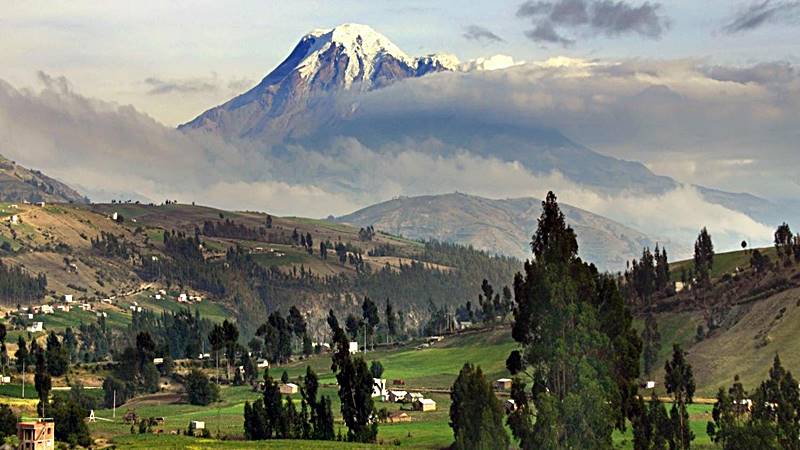Ecuador is divided into four main regions(Andes, Coast, Amazon, and Galapagos Islands), each offering its own unique landscapes, cultural experiences, and attractions.

Let’s explore each region: Andes, Coast, Amazon, and Galapagos Islands
The Sierra

The Sierra (Andean Highlands): The Sierra region is characterized by the majestic Andes Mountains that run through the center of Ecuador. It is home to picturesque valleys, stunning peaks, and indigenous communities.
- Majestic Peaks: The Sierra region of Ecuador is home to the awe-inspiring Andes Mountains, which boast several stunning peaks. Among them is Chimborazo, the highest volcano in Ecuador and the farthest point on Earth’s surface from the planet’s center due to the equatorial bulge. It offers breathtaking views and is a popular destination for mountaineers.
- Indigenous Markets: The Sierra region is renowned for its vibrant indigenous markets. One of the most famous is the Otavalo Market, where locals and visitors can immerse themselves in a kaleidoscope of colors and find traditional textiles, handicrafts, and unique souvenirs. It’s a captivating place to experience the indigenous culture and craftsmanship of the Andean communities.
- Colonial Charm: Quito, the capital of Ecuador, is nestled in the Sierra region and is a UNESCO World Heritage site. Its historic center, known as the Old Town, is a treasure trove of colonial architecture, narrow cobblestone streets, and beautifully preserved churches, such as the stunning Compañía de Jesús. Exploring this architectural marvel allows visitors to step back in time and appreciate the region’s rich history.
- Quilotoa Crater Lake: Located in the Sierra region, the Quilotoa Crater Lake is a mesmerizing natural wonder. Formed by the collapse of a volcanic cone, the lake’s emerald-green waters captivate visitors with their beauty. Hiking along the rim of the crater or descending to the lake’s shore provides breathtaking views and unique photo opportunities.
- Haciendas and Rural Life: The Sierra region is dotted with picturesque haciendas, traditional farm estates that offer a glimpse into Ecuador’s rural life. These historic properties often provide accommodations, allowing visitors to experience the region’s hospitality, indulge in local cuisine, and participate in activities such as horseback riding, hiking, and birdwatching.
- Adventure Sports: The Sierra region is a playground for adventure enthusiasts. Baños, a popular town nestled in the Andean foothills, is renowned for its outdoor activities. Visitors can go white-water rafting, canyoning, biking, or zip-lining, all while enjoying the stunning natural landscapes that surround them.


These interesting facts about the Sierra region of Ecuador highlight the captivating blend of natural beauty, cultural heritage, and thrilling adventures that await travelers in this enchanting part of the country.

The Costa

The Coastal region of Ecuador beckons travelers with its sandy beaches, abundant marine life, delicious cuisine, and dynamic urban centers. Whether you’re seeking relaxation, wildlife encounters, water sports, or urban adventures, this region provides a captivating coastal escape.

- Tropical Beaches: The Coastal region of Ecuador is blessed with stunning beaches along the Pacific coast. From the lively shores of Salinas and Montañita to the tranquil stretches of Puerto Lopez and Canoa, the region offers diverse coastal landscapes for sunbathing, surfing, and relaxation.
- Whales and Wildlife: The Coastal region is known for its rich marine life. Between June and September, humpback whales migrate to Ecuador’s coast, providing a unique opportunity for whale watching. Isla de la Plata, also known as the “Poor Man’s Galapagos,” is a must-visit destination for observing seabirds, including the famous blue-footed boobies.
- Mangrove Forests: The Coastal region is home to extensive mangrove forests, particularly in areas like the Gulf of Guayaquil and the Pacoche Reserve. These unique ecosystems support a wide array of flora and fauna, including mangrove crabs, shorebirds, and vibrant plant life. Exploring the mangroves by boat or kayak is a fascinating experience.
- Coastal Cuisine: The Coastal region offers a delectable culinary scene, heavily influenced by its proximity to the ocean. Seafood lovers will delight in fresh ceviche, shrimp dishes, grilled fish, and encocados (coconut-based seafood stews). Local markets and beachfront restaurants serve up these coastal delicacies with flavors that will leave your taste buds wanting more.
- Surfing Hotspots: Ecuador’s Coastal region has gained popularity among surfers, both beginners and professionals. Spots like Montañita, Ayampe, and Canoa offer consistent waves and a vibrant surf culture. Surrounded by a laid-back beach atmosphere, these towns provide the perfect setting for catching waves and enjoying the coastal lifestyle.
- Vibrant Port Cities: The Coastal region is home to bustling port cities, including Guayaquil, Ecuador’s largest city. Guayaquil showcases a mix of modernity and tradition, with a revitalized riverfront promenade, vibrant markets like the Malecón 2000, and historic neighborhoods such as Las Peñas. These cities offer a blend of cultural experiences, including museums, art galleries, and lively nightlife.


The Oriente (Amazon Rainforest)

The Oriente region of Ecuador is a gateway to the awe-inspiring Amazon rainforest, where nature, indigenous cultures, and wildlife converge. It offers a profound experience of immersion in the world’s largest tropical rainforest, with opportunities to witness unique rituals, encounter incredible biodiversity, and appreciate the delicate balance of this extraordinary ecosystem.
- Amazon Rainforest: The Oriente region of Ecuador is primarily composed of the Amazon rainforest, one of the most biodiverse and expansive tropical rainforests in the world. It encompasses dense vegetation, winding rivers, and a remarkable variety of plant and animal species.
- Indigenous Communities: The Oriente is home to several indigenous communities, including the Kichwa, Shuar, and Achuar. These communities have preserved their traditional ways of life, customs, and ancestral knowledge, offering visitors a unique opportunity to learn about their culture, rituals, and sustainable practices.
- Wildlife Abundance: The Oriente region is teeming with diverse wildlife species, including jaguars, tapirs, monkeys, colorful birds, and a myriad of reptiles and insects. Exploring the region allows for wildlife encounters through jungle hikes, river cruises, and visits to wildlife rescue centers and eco-lodges.
- Indigenous Rituals and Ceremonies: The Oriente is known for its spiritual connection to nature. Indigenous communities often perform traditional rituals and ceremonies that celebrate their relationship with the rainforest and its resources. Visitors may have the chance to witness and participate in ceremonies such as ayahuasca rituals and cleansing ceremonies.
- Sacred Waterfalls and Rivers: The Oriente region is adorned with captivating waterfalls and mighty rivers. Examples include the breathtaking waterfall of Pailón del Diablo and the powerful Napo River, a tributary of the Amazon River. These natural wonders offer opportunities for swimming, rafting, and peaceful contemplation in the midst of pristine surroundings.
- Canopy Walkways: The Oriente is famous for its canopy walkways, elevated platforms and suspension bridges that allow visitors to explore the rainforest canopy at different levels. Walking above the treetops provides a unique perspective, allowing for birdwatching, observing orchids and epiphytes, and gaining a better understanding of the rainforest’s intricate ecosystem.


Galapagos Islands
The Galapagos Islands: Situated around 1,000 kilometers off the coast of mainland Ecuador, the Galapagos Islands are a natural paradise and a UNESCO World Heritage site. This archipelago is renowned for its unique wildlife, including giant tortoises, marine iguanas, blue-footed boobies, and Galapagos penguins. Visitors can take cruises or stay on the inhabited islands of Santa Cruz, San Cristobal, and Isabela to explore the diverse landscapes, go snorkeling or diving, and learn about the ongoing conservation efforts.
- Biodiversity Hotspot: The Galapagos Islands are renowned for their exceptional biodiversity, hosting a vast array of unique plant and animal species found nowhere else on Earth. It’s like stepping into a living natural history museum.
- Evolutionary Discoveries: The islands played a crucial role in shaping Charles Darwin’s theory of evolution. The distinct species found on each island inspired his groundbreaking insights, leading to the development of this fundamental scientific concept.
- Galapagos Tortoises: These iconic giant tortoises are one of the most recognizable symbols of the islands. They can live for over a hundred years, and their remarkable size and longevity fascinate visitors from around the world.
- Marine Marvels: The Galapagos Islands offer exceptional opportunities for underwater exploration. Snorkeling or diving in the crystal-clear waters reveals a vibrant marine ecosystem teeming with colorful fish, sea turtles, playful sea lions, and even sharks.
- Unique Birdlife: The Galapagos Islands are a paradise for bird enthusiasts. From the remarkable blue-footed boobies to the graceful waved albatrosses and the endemic Galapagos penguins, these islands are a haven for birdwatchers seeking rare and fascinating species.
- Strict Conservation Efforts: The Ecuadorian government has implemented rigorous conservation measures to protect the delicate ecosystem of the Galapagos Islands. These efforts include visitor quotas, strict regulations, and ongoing scientific research to ensure the preservation of this remarkable natural heritage.
The Galapagos Islands remain a testament to the wonders of nature, where visitors can witness extraordinary wildlife, explore breathtaking landscapes, and gain a deeper understanding of our planet’s ecological processes.
Each region of Ecuador offers distinct experiences, whether it’s exploring colonial cities, hiking in the Andes, relaxing on pristine beaches, delving into the Amazon rainforest, or encountering endemic species in the Galapagos Islands. The country’s geographical diversity ensures that there’s something for every traveler to discover and appreciate.
Looking to expand your knowledge about Ecuador? Check out our Everything Ecuador Page!




